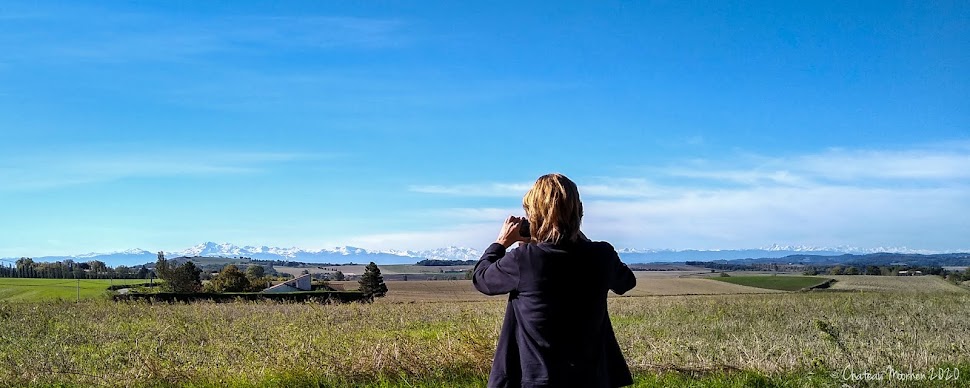We were lucky to learn from Facebook of a good orchid spot only about 15 minutes from home, so we shot off there on 2nd June to have a look. It really was a fantastic place and I clocked up another two orchids which I'd never seen before (that's not hard at the moment really!).
I was most hoping to find the Pink Butterfly Orchid (Anacamptis papilionacea) and we were given directions as to where they were in relation to the radio masts at the top of the hill. We only found a few of them, but there were literally hundreds of the Long-lipped Tongue Orchids (Serapias vomeracea) everywhere we looked which was just magnificent, interspersed with other orchids or wildflowers. Although another 15 mins inland from where we live there were still quite a lot of Mediterranean garrigue plants flowering here, or coming into bud.
Keith at the top of the hill with dozens of Tongue Orchids in the foreground - the same as the ones in the photo above around the Pink Butterfly Orchid. The white flower is Lotus dorycnium from the pea family and I refer to it further down as the larval host plant of a particular moth.
There were also some beautiful Bee Orchids (Ophrys apifera); some were pink and some white. They are very similar to the Woodcock Orchid (Ophrys scolopax) but I have learned how to tell the difference between the two using this link.
This is an Ophrys magniflora, very beautiful but I only found this one which was starting to go over. It is endemic to this department, the Aude.
Looking from the hillside towards the Corbieres hills in the far distance.
Amongst the wildflowers was quite a lot of thyme, as well as other Mediterranean plants, including Lavender.
In this shot there is Curry Plant (Helichrysum Italicum) in the foreground, in bud, plus the white flowers are Lotus dorycnium which I talk about a bit further down. If you click on these photos you will see them much larger and see far more detail.
All over this hillside I was surprised to see this beautiful blue flower which is called Aphyllanthes monspeliensis, usually seen all over the rocky coastal garrigues. It's an unusual plant, with no leaves as such, just long stems rather like chives with flowers on the end of some of them.
There were a fair few butterflies about but absolutely loads of Burnet moths of the Zygaena genus - mostly Six-spot and this one below which is Zygaena lavandulae; though I have only just learnt the common name I have forgotten it already! It's not the Lavender Burnet, despite its name! I've only seen it before close to the coast (about 1hr 25 mins from here) so it was interesting to see it inland, though it is in its natural habitat in terms of larval foodplant and rocky flowery hillsides. In fact one of the larval foodplants is Lotus dorycnium, which grows all over the slope opposite my house, but so far I've only seen Six-spot Burnet at home. In this photo there are two of them, one showing its underside and one the topside.
One more pink Bee Orchid to finish off!
I won't have time to write about our recent trip up to the mountains before we leave on Sunday for Provence (it's all go here!). Let me just sum it all up in one word. INCREDIBLE! I will need to do about four posts so I'll get to it eventually. 😀

























